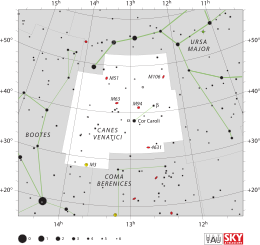Canes Venatici
| Constellation | |
 | |
| Abbreviation | CVn |
|---|---|
| Genitive | Canum Venaticorum |
| Pronunciation | /ˈkeɪniːz vɪˈnætɪsaɪ/ Cánes Venátici, genitive /ˈkeɪnəm vɪnætɪˈkɒrəm/ |
| Symbolism | the Hunting Dogs |
| Right ascension | 13 |
| Declination | +40 |
| Quadrant | NQ3 |
| Area | 465 sq. deg. (38th) |
| Main stars | 2 |
| Bayer/Flamsteed stars | 21 |
| Stars with planets | 4 |
| Stars brighter than 3.00m | 1 |
| Stars within 10.00 pc (32.62 ly) | 2 |
| Brightest star | Cor Caroli (α CVn) (2.90m) |
| Messier objects | 5 |
| Meteor showers | Canes Venaticids |
| Bordering constellations | Ursa Major Boötes Coma Berenices |
| Visible at latitudes between +90° and −40°. Best visible at 21:00 (9 p.m.) during the month of May. | |

Canes Venatici is a constellation in the northern sky. It means "the hunting dogs" in Latin. It was named and created by the Polish astronomer Johannes Hevelius in 1687.[1] The astronomer named Ptolemy included it in Ursa Major when he made a list of 48 constellations in the 2nd century. Canes Venatici is not a very bright constellation.
Deep-sky objects[change | change source]
References[change | change source]
- ↑ Ridpath, Ian. "Canes Venatici: the Hunting Dogs". Star Tales. Retrieved 27 January 2013.
